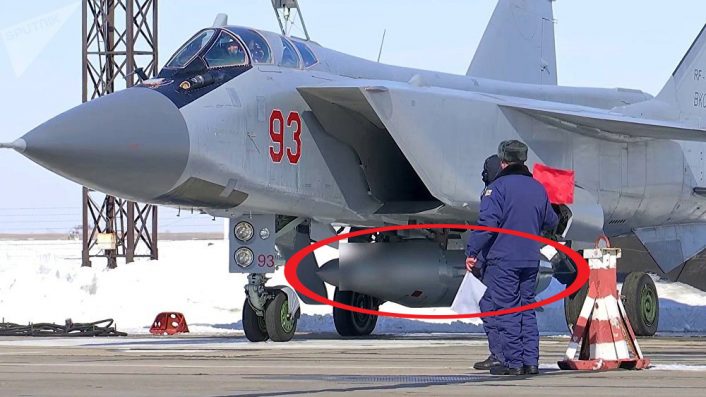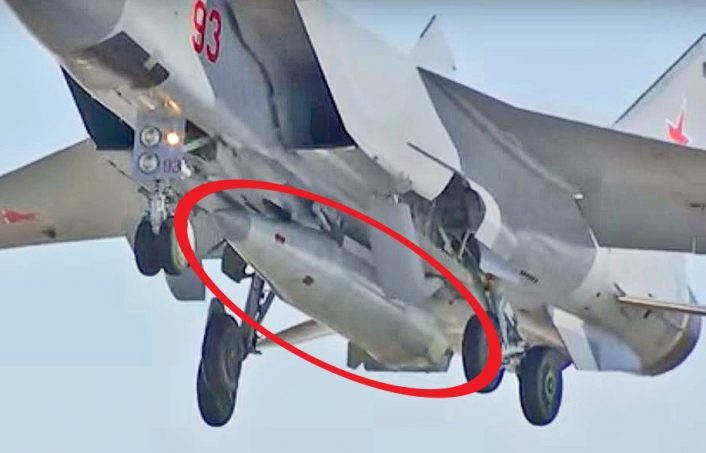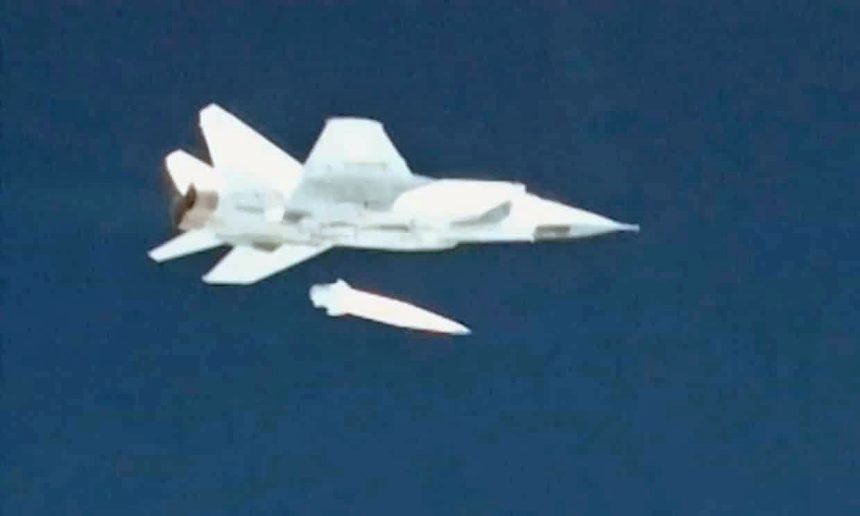First “Kinzhal” Fired from MiG-31 in Southwest Russia Hits Target According to Russians. But it’s a modified Iskander SRBM.
The Russian Aerospace Forces have conducted the first successful test firing of the air-launched Kinzhal (Dagger) hypersonic missile according to state sponsored media outlets.
The missile, supposedly named Kh-47M2 and referred to as the “Kinzhal”, was fired from a modified MiG-31BM (NATO reporting name “Foxhound”) over Southwest Russia. A report published on Facebook by Russian Deputy Prime Minister Dmitry Rogozin said the “unique” MiG-31 that fired the missile had been “modernized”. Rogozin did not specify what modifications or “modernized” meant.
In video and still photos portions of the weapon seen in the test launch are obscured by imaging software, presumably for security purposes.
The official news release from the Russian Aerospace Forces read in part, “MiG-31 jet of the Russian Aerospace Forces conducted a test launch of hypersonic aviation and missile system Kinzhal in a set district. The launch was successful, the hypersonic missile hit the designated target at the field.”
Kinzhal is claimed to be a strategic air-to-surface strike missile. The missile is claimed to have maneuverable flight characteristics not typically seen in hypersonic, solid fuel missiles. Observers of Russian missile programs have voiced skepticism about Russia’ performance claims however. According to Russians and reference sources the Kinzhal missile has a top speed of Mach 10 and maintains some ability to maneuver throughout its performance envelope including at hypersonic speed. If accurate, these capabilities could make the Kinzhal difficult to intercept by anti-missile systems. The missile is reported to have a range of 1,200 miles (approximately 2,000 kilometers). This, added to the reported 1,860-mile unrefueled range of the MiG-31BM long range, supersonic interceptor, gives the Kinzhal potentially intercontinental strike capability. The missile is also reported to be nuclear-capable and able to hit ground as well as naval targets.

Writer and analyst Kelsey T. Atherton wrote in Popular Mechanics, “Don’t believe the hype about Russia’s hypersonic missile” back in June, 2017 when discussing Russia’s Zircon missile, a sea launched hypersonic missile. The War Zone’s Tyler Rogoway compared the new Kinzhal with Russia’s existing Iskander short-range ballistic missile in his analysis.
This first Russian Kinzhal test comes several months after the Indian Brahmos-A hypersonic missile test from November 22, 2017. The reported performance of the Indian Brahmos was a top speed of Mach 7 and a range of 290 kilometers. The Indian hypersonic missile was launched from a modified Sukhoi Su-30MKI. The Indian hypersonic missile project was completed in close cooperation with the Russians.

Hypersonic cruise missiles have the capability to defeat or degrade the effectiveness of most current surveillance and anti-missile systems because of their speed (and, in the case of this new Kinzhal, claimed capability to maneuver). The choice of the aging MiG-31, that would probably launch the Kinzhal from +60,000 feet at supersonic speed, is aimed at giving the tactical ballistic missile much more reach than it would have if launched from the ground: indeed, during the Cold War, the long-range high-altitude interceptor was supposed to be used as launch platform for anti-satellite weapons that could destroy targets in near space. Capable to carry up to four long-range R-33 missiles and four short-range R-77 missiles, not only was the MiG-31BM expected to carry a weapon able to shoot down space satellites; it was also intended to be used as a “cruise missile interceptor”: the Foxhounds have been involved in tests to intercept cruise missiles, previously Kh-55 and more recently Kh-101, for years.
While the Kinzhal appears to be an air-to-ground missile the pairing of this nuclear capable hypersonic missile recalls the much older AIR-2 Genie nuclear armed air-to-air missile with a 1.5 kiloton warhead. The AIR-2 Genie and earlier versions of the same missile were deployed by the U.S. Air Force from 1957-1962.
In remarks from an earlier state of the nation address at the beginning of March, Russian President Vladimir Putin told media that the Kinzhal has been “operational” prior to this test launch. Russian media also said there had been “250 test flights” to validate the operational status of the Kinzhal prior to this test launch. There was no mention if the missile or any more of the modified MiG-31s are operationally deployed yet.
According to defense journalist Babak Taghvaee, six MiG-31BM interceptors have already been turned into launch platforms and they are based at Akhtubinsk:
By the end of 2018, #RuAF #Russia|n Air Force will form an Aviation Squadron with 10-12 MiG-31BMs especially modified for carrying the Dragger Hypersonic Missile in one of its Fighter Regiments. For now six MiG-31BMs are modified to carry the missile. They are now in Akhtubinsk. https://t.co/KKsex2FCKj
— Babak Taghvaee (@BabakTaghvaee) March 11, 2018
In contrast with the Russian claims, while traveling to Oman, U.S. Defense Secretary James Mattis told reporters that nothing Russia demonstrated changed the Pentagon’s perspective.
“I saw no change to the Russian military capability and each of these systems that he’s talking about are still years away, I do not see them changing the military balance. They do not impact any need on our side for a change in our deterrence posture.” Indeed, the missile seems to fuel the propaganda machine more than it actually changes the strategic balance. However, it’s a development worth following, especially if we consider the maritime strike capability that an air-launched ballistic anti-ship missile brings in the game.
Russia’s firing of the Kinzhal joins not only the Indian hypersonic missile tests from last year but also the Chinese DF-17 hypersonic glide missile tests and the U.S. tests of hypersonics being conducted by the Defense Advanced Research Projects Agency (DARPA), NASA and the U.S. Air Force.









